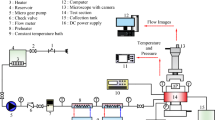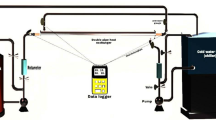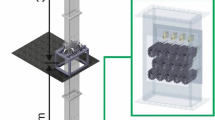Abstract
In this study, a design of an aluminum alloy pin-fin heat sink with the passage divider and the packed brass beads was proposed. The effects of the passage divider and packed brass beads on the overall heat transfer performance of the pin-fin heat sink under forced convection with water cooling was investigated experimentally. The heat sink is made of an aluminum alloy square cavity with the in-line square pin fins as the basic configuration. Among them, the number of pin fins (4 × 4, 3 × 3, 2 × 2, 0 × 0) and the height of pin fins (H = 5, 10, 20 mm) are variables. The filled brass beads have three particle sizes (d = 4, 6 and 8 mm), and the passage divider designs are divided into 2 types, namely, left-and-right S-shape divider and up-and-down S-shape divider. The results indicate that for the heat sink with the passage divider but no filled with brass beads, the passage divider has a significant heat transfer enhancement for the 4 × 4 and 3 × 3 pin-fin heat sink. Especially for the 3 × 3 pin-fin heat sink added with the up-and-down S-shape divider, the heat transfer enhancement is up to 60%. For the heat sink with the passage divider and filled with brass beads, when adding the same passage divider, compared with the test case without filled with the brass beads, the filling of brass beads (d = 4 mm) has a significant heat transfer enhancement for the heat sink with H = 5 and 10 mm. It increases the heat transfer by an average of about 14%. Therefore, in the test case, the 3 × 3 pin-fin heat sink (H = 10 mm) added with the up-and-down S-shape divider and filled with brass beads (d = 4 mm) has the most significant heat transfer enhancement, and the overall Nusselt number increases by about 65% compared with the heat sink without the passage divider and brass beads.











Similar content being viewed by others
Abbreviations
- A :
-
Heating surface area [m2]
- d :
-
Inner diameter of inlet joint at the heat sink or diameter of brass beads [m]
- H :
-
Height of pin fins [m]
- k :
-
Thermal conductivity [W/m/K]
- L :
-
Side length of heat sink [m]
- Nu :
-
Nusselt number, Eq. (2)
- Q :
-
Heat [W]
- Re :
-
Reynolds number, Eq. (1)
- s :
-
Side width of pin fins [m]
- T :
-
Temperature [°C]
- ρ :
-
Density [kg/m3]
- μ :
-
Dynamic viscosity [N-s/m2]
- f :
-
Fluid
- Loss :
-
Heat loss
- t :
-
Total
- w :
-
Heated wall
References
Nikkhah V, Sarafraz MM, Hormozi F, Peyghambarzadeh SM (2015) Particulate fouling of CuO-water nanofluid at isothermal diffusive condition inside the conventional heat exchanger-experimental and modeling. Exp Thermal Fluid Sci 60:83–95
Nikkhah V, Sarafraz MM, Hormozi F (2015) Application of spherical copper oxide (II) water nano-fluid as a potential coolant in a boiling annular heat exchanger. Chem Biochem Eng Q 29:405–415
Salari E, Peyghambarzadeh M, Sarafraz MM, Hormozi F (2016) Boiling heat transfer of alumina nano-fluids: role of nanoparticle deposition on the boiling heat transfer coefficient. Period Period Polytech Chem 60:252–258
Arani AAA, Akbari OA, Safaei MR, Marzban A, Alrashed AAAA, Ahmadi GR, Nguyen TK (2017) Heat transfer improvement of water/single-wall carbon nanotubes (SWCNT) nanofluid in a novel design of a truncated double-layered microchannel heat sink. Int J Heat Mass Transf 113:780–795
Sarafraz MM, Arya A, Hormozi F, Nikkhah V (2017) On the convective thermal performance of a CPU cooler working with liquid gallium and CuO/water nanofluid: a comparative study. Appl Therm Eng 112:1373–1381
Sarafraz MM, Nikkhah V, Madani SA, Jafarian M, Hormozi F (2017) Low-frequency vibration for fouling mitigation and intensification of thermal performance of a plate heat exchanger working with CuO/water nanofluid. Appl Therm Eng 121:388–399
Sarafraz MM, Nikkhah V, Nakhjavani M, Arya A (2017) Fouling formation and thermal performance of aqueous carbon nanotube nanofluid in a heat sink with rectangular parallel microchannel. Appl Therm Eng 123:29–39
Sarafraz MM, Arjomandi M (2018) Demonstration of plausible application of gallium nano-suspension in microchannel solar thermal receiver: experimental assessment of thermo-hydraulic performance of microchannel. Int Commun Heat Mass 94:39–46
Sarafraz MM, Arya H, Arjomandi M (2018) Thermal and hydraulic analysis of a rectangular microchannel with gallium-copper oxide nano-suspension. J Mol Liq 263:382–389
Rizk TA, Kleinstreuer C (1991) Forced convective cooling of a linear array of blocks in open and porous matrix channels. Heat Transfer Eng 12:40–47
Bhattacharya A, Mahajan RL (2002) Finned metal foam heat sinks for electronics cooling in forced convection. ASME J Electron Packag 124:155–163
Jeng TM, Tzeng SC (2006) Study of flow and heat transfer characteristics in asymmetrically heated sintered porous heat sinks with periodical baffles. ASME J Electron Packag 128:226–235
Tzeng SC, Jeng TM, Wang YC (2006) Experimental study of forced convection in asymmetrically heated sintered porous channels with/without periodic baffles. Int J Heat Mass Transf 49:78–88
Tzeng SC (2006) Spatial thermal regulation of aluminum foam heat sink using a sintered porous conductive pipe. Int J Heat Mass Transf 50:117–126
Jeng TM, Tzeng SC, Tang FZ (2010) Fluid flow and heat transfer characteristics of the porous metallic heat sink with a conductive cylinder partially filled in a rectangular channel. Int J Heat Mass Transf 53:4216–4227
Jeng TM, Tzeng SC, Chen YC (2011) Thermal characteristics in asymmetrically heated channels fully filled with brass beads. Int J Therm Sci 50:1853–1860
Jeng TM, Tzeng SC, Xu R (2014) Experimental study of heat transfer characteristics in a 180-deg round turned channel with discrete aluminum-foam blocks. Int J Heat Mass Transf 71:133–141
Jeng TM, Tzeng SC, Xu GW (2014) Flow visualization of fluid flow through a U-bend channel with periodical high-permeability porous blocks. Int Commun Heat Mass 57:91–99
Jeng TM, Tzeng SC, Huang QY (2015) Heat transfer performance of the pin–fin heat sink filled with packed brass beads under a vertical oncoming flow. Int J Heat Mass Transf 86:531–541
Jeng TM, Tzeng SC (2015) Numerical simulation of laminar forced convection of pin-fin heat-sink array in a channel by using porous approach. Appl Sci 5:1846–1868
Lu W, Zhang T, Yang M (2016) Analytical solution of forced convective heat transfer in parallel-plate channel partially filled with metallic foams. Int J Heat Mass Transf 100:718–727
Bayomy AM, Saghir MZ (2016) Heat transfer characteristics of aluminum metal foam subjected to a pulsating/steady water flow: experimental and numerical approach. Int J Heat Mass Transf 97:318–336
Wang K, Tu XC, Bae CH, Kim HB (2015) Optimal design of porous baffle to improve the flow distribution in the tube-side inlet of a shell and tube heat exchanger. Int J Heat Mass Transf 80:865–872
Shih WH, Liu CC, Hsieh WH (2016) Heat-transfer characteristics of aluminum-foam heat sinks with a solid aluminum core. Int J Heat Mass Transf 97:742–750
Naphon P, Wiriyasart S (2009) Liquid cooling in the mini-rectangular fin heat sink with and without thermoelectric for CPU. Int Commun Heat Mass 36:166–171
Jajja SA, Ali W, Ali HM, Ali AM (2014) Water cooled minichannel heat sinks for microprocessor cooling: effect of fin spacing. Appl Therm Eng 64:76–82
Song X, Lyu Z, Li G, Hu X (2017) Numerical analysis of the impact flow field of multi-orifice nozzle hydrothermal jet combined with cooling water. Int J Heat Mass Transf 114:578–589
Ma J, Wang Y, Feng X (2017) Simultaneous optimization of pump and cooler networks in a cooling water system. Appl Therm Eng 125:377–385
Moffat RJ (1982) Contributions to the theory of single-sample uncertainty analysis. J Fluid Eng-T ASME 104:250–258
Acknowledgements
The authors would like to thank the Ministry of Science and Technology of the Republic of China for financially supporting this research under Contract Nos. MOST 107-2221-E-270-003-MY2, MOST 107-2637-E-270-001 and MOST 107-2622-E-270-003-CC3.
Author information
Authors and Affiliations
Corresponding author
Additional information
Publisher’s note
Springer Nature remains neutral with regard to jurisdictional claims in published maps and institutional affiliations.
Rights and permissions
About this article
Cite this article
Jeng, TM., Tzeng, SC., Tseng, CW. et al. Effects of passage divider and packed brass beads on heat transfer characteristic of the pin-fin heat sink by water cooling. Heat Mass Transfer 56, 1429–1441 (2020). https://doi.org/10.1007/s00231-019-02725-8
Received:
Accepted:
Published:
Issue Date:
DOI: https://doi.org/10.1007/s00231-019-02725-8




